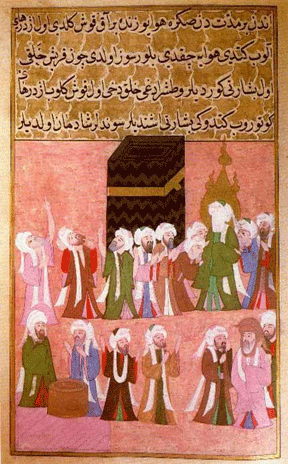
Mohammed at the Kaaba. Miniature from the Ottoman Empire, c. 1595. Source: The Topkapi Museum, Istanbul
Folk Astronomy and Islamic Ritual
Astronomy was relevant to Muslims in large part because of several of the ritual duties proscribed in the Quran and Islamic tradition. The three most important of these are determining the beginning of the fasting month of Ramadân, reckoning the times for the five daily prayers, and determining the proper direction of the qibla or sacred direction toward Mecca. While Muslim astronomers later worked out mathematical solutions to some of these problems, correct timing and orientation could be achieved by those untrained in astronomy and with virtually no computation skills beyond simple arithmetic (King 1985:194).
The primary means of fulfilling the timing or direction for rituals was based on observation. The start of fasting in Ramadân was tied to the appearance of the lunar crescent, which could often be directly observed. In the case of bad weather one technique used was to count months of roughly 29 1/2 days each in pairs (Renaud 1945). Timekeeping for the five required daily prayers differed according to whether it was day or night. There was considerable discussion in the religious law as to when each prayer should be performed. Al-Misrî (1991:110-111), a 14th century jurist of Shâfi‘î law, said the morning subh prayer was to be done between what was called “true dawn,†when the sky around the horizon begins to grow light, and actual sunrise. The time for the noon prayer (zuhr) was after the sun’s zenith and before an object’s shadow, minus the length of its shadow at the time of the sun’s zenith, equals the object’s height. The midafternoon ‘asr prayer starts after the period for the noon prayer, but the preferred time ends when an object’s shadow minus the length of its shadow at the sun’s zenith is twice as long as the object’s height. The sunset or maghrib prayer begins after the sun has completely set. The time for the evening ‘ishâ’ prayer begins when the red of sunset leaves the sky until true dawn, although the preferred time ends after a third of the night has passed.
One of the folk methods used for determining the daylight prayers was based on the observation of shadow lengths (King 1990). This was commonly done by use of a gnomon or measuring one’s own shadow according to one’s own feet. Zuhr begins shortly after midday as the shadow is observed to increase, while ‘asr starts when the shadow has increased over its midday minimum by the length of the gnomon (n). The end of the period for the ‘asr prayer, as noted in the legal texts, is when the shadow has increased by twice the length of the gnomon. The most common Islamic base for the gnomon length was 7 foot-lengths, although measures of 6, 6 1/2 and 6 2/3 were also used. This length was thought to be equivalent to the height of a man (qâma) to the length of his foot (qadam). Sometimes these measurements are made for each of the 13-day periods defined by the 28 lunar mansions.
Observation on a given night of the rising and setting of the lunar stations yielded an approximate clock for time reckoning when stars were visible. This was based on the idea of each station representing about 13° of arc along the ecliptic. Thus, a pure horizon of 180° would allow 14 or half of the 28 lunar stations visible in the night sky at any one time. One observes the first station rising after sunset and tracks its course through the night; theoretically a new station arose each 6/7 of an hour, i.e. 14 stations rising over the course of 12 hours. Obviously, this was an approximate system, but it served a useful function before more accurate scientific measures were available.
A major stimulus to the growth of mathematical astronomy was the need to determine the qibla or direction of Mecca from all the places Islam was spreading to. A wide variety of nonmathematical means were used, including observation of the rising and setting points of the sun, moon and stars, as well as orientation according to the winds. In his survey of early Islamic texts, King (1985:320) has documented a variety of these folk methods. For example, it is said that the qibla in northwest Africa is toward the rising of the sun at the equinoxes, in Egypt toward the rising of the sun at midwinter, in Yemen towards the direction from which the north wind blows or the Pole Star, in Syria towards the star Canopus, in Iraq towards the setting of the sun at midwinter, and in India towards the setting of the sun at the equinoces. In various regions there were disagreements over how to determine the qibla.
References
King, David A. “The sacred direction in Islam: A study of the interaction of religion and science in the Middle Ages.†Interdisciplinary Science Reviews 10:4:315-328, 1985.
al-Misrî, Ahmad ibn Naqîb. The Reliance of the Traveller. Edited and translated by Noah Ha Mim Keller. Evanston: Sunna Books, 1991.
Renaud, H. P. J. “Sur les lunes de Ramadan.†Hespéris 32:51-58, 1945.
Excerpt from Daniel Martin Varisco. Islamic Folk Astronomy, In The History of Non-Western Astronomy. Astronomy Across Cultures, pp. 615-650. Edited by Helaine Selin. Dordrecht: Kluwer Academic Publishers, 2000.
For Islamic Folk Astronomy #2, click here.